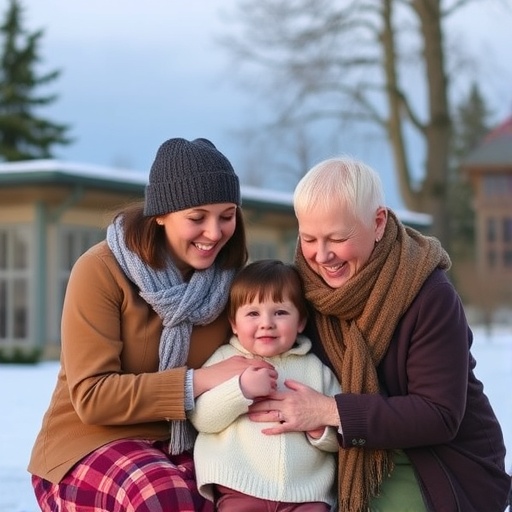In an illuminating exploration that transcends cultural boundaries, the collaborative research conducted by Mohamed Hussin and Aho investigates the intricate dynamics of faith and spirituality among Finnish parents grappling with the unimaginable heartache of losing a child. The study, titled “Navigating Faith: Religion and Spirituality Among Finnish Parents After the Traumatic Loss of a Child,” elucidates the myriad ways in which spirituality shapes grief, offering profound insights into the human condition.
The research is particularly timely, given the increasing awareness of psychological health in the wake of personal tragedies. With the wariness surrounding mental health issues, Hussin and Aho’s insights present a beacon of understanding for both practitioners and parents who find themselves floundering in the turbulent seas of sorrow. Their rigorous inquiry delves into how spiritual beliefs act as a coping mechanism, offering solace and a means of making sense of tragic loss.
In the aftermath of a child’s death, parents often confront an overwhelming sense of despair and isolation. Hussin and Aho contend that spirituality can serve as a bridge connecting individuals to both their inner selves and to a broader community of support. In many cases, traditions rooted in religious belief can provide structure during moments of chaotic emotional upheaval. This study illustrates how specific Finnish cultural practices intertwine with spiritual beliefs to form a coping mechanism that resonates deeply with affected parents.
Throughout the research, the authors utilized various qualitative methods to gather data, including interviews and surveys from Finnish parents. The responses revealed a tapestry of beliefs and practices, thus painting a vivid portrait of how faith influences the grieving process. Participants articulated feelings ranging from anger and disillusionment to hope and renewal, all shaped by individual spiritual frameworks. This emotional complexity is at the heart of Hussin and Aho’s findings, showcasing the multifaceted nature of grief.
A noteworthy aspect of the study involves the contrasting experiences of parents from different religious backgrounds. Those rooted in more traditional faiths spoke often about the role of communal worship and shared rituals in their healing journeys. On the other hand, parents with non-religious affiliations leaned more heavily into personal spirituality, exploring alternative forms of meaning-making in the absence of structured religious support. This distinction challenges the binary classification of religious and non-religious approaches, revealing a spectrum of beliefs that influence resilience in the face of tragedy.
Moreover, Hussin and Aho’s work takes into account the necessity of cultural context in understanding grief. Finnish culture, with its unique relationship to nature and community, provides a fertile ground for these parents to explore their spirituality. They illustrated how connections to the natural world—like the shifting seasons or the serene beauty of Finnish landscapes—often invoked a greater sense of purpose and connectedness, reinforcing the idea that spirituality is not solely confined to traditional practices.
The implications of the findings reach beyond the individual level, suggesting that community support plays an essential role in collective healing. The study indicates that parents who engage in shared communal activities—whether through religious services or social support groups—often report both emotional and psychological benefits. Such connections foster an environment of empathy and understanding, which is crucial for grieving parents who may feel stigmatized by their loss.
This exploration is not without its challenges; navigating the landscape of grief is inherently complex and deeply personal. Each parent’s experience of loss is shaped by a multitude of factors, including personal history, relationship with the deceased, and existing mental health conditions. The study suggests that recognizing these individual differences is key to providing effective support for grieving parents.
Furthermore, Hussin and Aho underscore the importance of flexibility in faith and belief systems. The evolving nature of spirituality is highlighted, showing how the experience of grief can lead to transformative shifts in personal belief. As parents journey through their loss, their understanding of faith may adapt, ultimately shaping how they view life, death, and their own existence.
The research also notes potential pitfalls. While spirituality can offer comfort, it can also complicate the grieving process for some parents who may struggle with feelings of anger toward their faith or questions of divine justice. The duality of faith—its capacity to heal and to hurt—emphasizes the need for continued dialogue among mental health professionals, spiritual leaders, and grieving families.
As the world becomes more interconnected, the study’s insights are particularly relevant. Grieving is a universal experience, but the responses to that grief can vary dramatically depending on cultural beliefs and practices. The Finnish context serves as a microcosm for broader discussions about faith, loss, and the human experience, providing valuable lessons for other cultures grappling with similar issues.
In conclusion, “Navigating Faith: Religion and Spirituality Among Finnish Parents After the Traumatic Loss of a Child” stands as a significant contribution to the field of pastoral psychology. Hussin and Aho invite readers to reflect on the intricate relationship between spirituality and grief, advocating for a nuanced understanding of how faith can empower individuals during their darkest hours. By fostering empathy and encouraging open conversations about loss and faith, society can better support those navigating the profoundly difficult journey of grief.
Subject of Research: The role of faith and spirituality in coping with the loss of a child among Finnish parents.
Article Title: Navigating Faith: Religion and Spirituality Among Finnish Parents After the Traumatic Loss of a Child.
Article References:
Mohamed Hussin, N., Aho, A. Navigating Faith: Religion and Spirituality Among Finnish Parents After the Traumatic Loss of a Child. Pastoral Psychol 74, 635–652 (2025). https://doi.org/10.1007/s11089-025-01237-z
Image Credits: AI Generated
DOI:
Keywords:




